The Illegal Immigration
By GREGORY KATZ, Associated Press Writer
The story is detailed in more than 400 pages of formerly secret documents at Britain's National Archives made available to the public on [ ]
The Jews aboard the Exodus were trying to enter Palestine illegally during the tumultuous months in 1947 before the United Nations voted to create a Jewish homeland in part of Palestine.
Britain was still governing Palestine and the British government felt it had to keep the immigrants out to preserve the demographic balance between Arab and Jew. But Britain did not have a safe place to send the Jews from the Exodus, who were placed on three smaller British steamers.
After much agonizing, the British concluded that the only place they could send the Jews was to the British-controlled zone of postwar Germany, where the Jews could be placed in camps and screened for extremists.
After Germany, many of the passengers were eventually detained in military camps in Cyprus along with other Jews deported from Palestine. When the state of Israel was founded in 1948, the Exodus' passengers were able to move there.
by SHIMON KAUFMAN, Los Angeles, 1958
World War II is over
1946 was a year to which we American Habonim had long looked forward. World War II had ended, and the dream of aliya was now an immediate objective. The years of preparation at Cream Ridge and the periods of military service were over. Military victory was ours, and Hitler had reached his ignominious end. Every one looked forward to a new and better world, and we were all certain that Britain would at last allow the broken remnant of European Jewry to return to its ancient homeland and that we American chalutzim would also soon be on our way to join them in building a new life in Palestine.
Jewish people are considered intruders
These fond hopes were not to be realized so quickly. The British Labor party, whose sympathy and promises had encouraged us in some of our darkest moments, had, upon coming to power, turned our fate over to the callous hands of Ernest Bevin. We soon learned that Mr. Bevin regarded the Jewish people as intruders on the Near Eastern landscape and that his best advice to the Jewish survivors of the death camps was to return to the cemeteries that their former homes had become. Nor did he hesitate to slam the doors in the faces of American chalutzim. The British would welcome no Jew to Palestine, be he a stateless displaced person, an American, or even a British citizen.
It was during this period that we began to hear rumors about Aliya Bet, the so-called "illegal" immigration. Soon the press began to report regularly about the small, over laden ships that plied the Mediterranean and secretly attempted to land their human cargo at remote spots along the; Palestinian shore. It was not long before some of our comrades had the opportunity to participate in this activity. Two demobilized Canadian corvettes were acquired, and they sailed for Europe manned by Jewish volunteers. These two ships, the Hagana and the Wedgwood, -were to bring thousands of Jewish refugees from southern European poirts to Palestine, where they were finally captured by the British navy. 'The passengers and crews were interned at Atlit for a while before being given their freedom. The ships were left to rust at anchor off the Haifa breakwaters, but their story had a heroic sequel: they were to become the "capital ships" of the Israel navy during the War of Independence.
The front door to Palestine was firmly closed
Those of us who were discharged from the armed forces too late to sail on the Hagana and the Wedgwood felt a keen sense of frustration. The political fate of Palestine was far from settled; and we, as well as our chaverot, felt that we, personally, must help determine that fate. But the front door to Palestine was held firmly closed. It was necessary to find a back door. So, before long, various "experiments" were proposed. Whenever any possible method of getting to Palestine might present itself, a few people would attempt the trip. If it succeeded, others would follow.
We sail to France
So it was that, during the late summer of 1946, we were among two very small groups of American chalutzim who sailed for France with the objective of participating in the work of the Aliya Bet in the south of France and eventually sailing for Palestine in one of the "illegal" ships.
Cloak-and dagger atmosphere of the operation
The trip across the Atlantic was uneventful. We docked in the rubble of war-flattened LeHavre and immediately bearded a train for Paris. There we met the Palestinians who were in charge of the functioning of Aliya Bet. There, too, we became aware of the cloak-and dagger atmosphere of the operation. We knew that the names of these people were aliases; only later, when we met many of them in Palestine, were we to learn their real names.
The chateau had been confiscated by the French government from pro-Nazi gentry
After a few, too brief days of sightseeing in Paris, we took the overnight train to Marseilles. There we reported to the Hechalutz office, which was the nerve center of the extensive operations of Aliya Bet in Southern France. We were invited to have our noon meal at one of the camps in the Marseilles area. A half-hour trolley ride brought us to a suburb away from the center of the city. Here we had our first glimpse of a typical transit camp of the Aliya Bet. We entered the gate of a rather large estate. The walled-in grounds must have comprised five or six acres. The main building was a rambling, two-story affair of large, high-ceilinged rooms. Except for a kitchen and supply room on the ground floor, most of the rooms were crowded with cots, dormitory style. As the weather was still warm, crude dining tables and benches occupied the yard outside the kitchen, and all meals were served outdoors. Grouped around the sides and front of the chateau were some fifteen Army tents, each crowded with cots. The chateau was in a state of general disrepair and showed little evidence of its one-time grandeur. The grounds, too, were neglected and unkempt. We learned later that these chateau had been confiscated by the French government from some of the pro-Nazi gentry and were, through unofficial channels, placed at the disposal of the Aliya Bet.
Two hundred souls, mostly survivors of Nazi death camps, had been brought from Germany
Such was the physical appearance of the camp. Here were lodged and fed some two hundred souls, mostly survivors of Nazi death camps, who had been brought from Germany to await the next Hagana ship for Palestine.
Daphne camp in Salon in Provence
The next day we traveled by bus to the town of Salon in Provence. In Salon and environs were the three camps which were to be the center of our activities for the next four months. First we went to the camp called Daphne, which was about five kilometers from the town. This place was much like the first camp we had visited in Marseilles, except that it was in the open country. This estate was not surrounded by a wall, and the resulting air of freedom was a welcome change to the former concentration-camp inmates, who had spent so many years behind walls and barbed wires. At Daphne we learned what our duties were to be. As Americans traveling on valid passports, we were able to move about freely. Most of the Hagana commanders of the camps were in France by the grace of group transit visas, which granted them the right to await transportation to some South American country which had formally granted them a visa. But they were required by the French police to remain quietly in the camps until they boarded ships, which sometimes meant for a month or two.
The daily program
The camps were all administered by Palestinians, Hagana people who had much experience in dealing with the survivors of the Nazi death camps and who knew much about crossing borders in a semi legal manner. Actually, each camp had a military-command setup. A Hagana member was the "commander." The daily program, which allotted time for various activities, was designed both to prevent dissatisfaction due to idleness and boredom, and to prepare the immigrants for the hazardous journey ahead. We arose early, cleaned our rooms and made our beds according to schedule, and ate in shifts in an orderly manner. Work details were chosen regularly for the kitchen, general policing of the area, and maintenance of buildings and equipment.
A new convoy of immigrants was soon to arrive
Several weeks after our arrival, most of the occupants of our camps boarded ship and sailed for Palestine. A new "convoy" of immigrants was soon to arrive from Germany, and we occupied ourselves making the camps ready for their arrival.
Six hundred fifty anxious immigrants disembarked from the train
Late one afternoon, in November, 1946, an unheralded train pulled onto a siding near the railroad station in Salon. It was made up of a motley assortment of old passenger cars and several freight cars, all with German markings. The Hagana representatives stepped forward to meet the men who guarded the train, who were, to my surprise, United States military police. The sergeant in charge received a signed receipt for his cargo; and six hundred fifty anxious immigrants disembarked from the train and boarded trucks, which quickly set out for the nearby camps. This whole operation was screened from the inquisitive public by a cordon of French police who kept passers-by away from the area.
Victims of Nazi mistreatment were fed and clothed by the American military
The reason behind this unpublicized cooperation of the U.S. army was that the American Zone of Germany had become the gathering place to which tens of thousands of Jewish survivors from every corner of Europe were flocking. As victims of Nazi mistreatment, they were fed and clothed by the American military, which soon found itself swamped by the ever-growing tide. And so, whenever there was an opportunity to alleviate the situation by getting groups of Jews to move on to France or Italy en route to other destinations, the Americans were only too happy to provide transportation without scrutinizing too closely the validity of transit papers and visas.
Setting sail for Palestine
Many weeks passed, and the immigrants began to grow restless; but no ship was available. The long wait allowed much time for speculation on the ultimate success of the venture upon which we were all embarked. It was common knowledge that, although ships of the Aliya Bet did, on occasion, succeed in landing their passengers on the Palestinian coast, the British navy had set up a full-scale blockade of the coastline and few ships now managed to sail through undetected. Capture by the British usually meant that the passengers of the ship would be interned for some months at Atlit, a large army camp south of Haifa. Upon their release, the required number of immigration certificates would be deducted from the small quota that was still being granted for Jewish immigration from Europe. However, as the volume of unauthorized immigration swelled, Mr. Bevin determined to take more drastic action to put an end to it. In the summer of 1946, the British navy captured a boatload of immigrants off the coast of Palestine. Upon arrival in Haifa, these immigrants were immediately transferred to a British troop ship, which set sail at once for the island of Cyprus.
Detoured to Cyprus
On Cyprus, the bewildered British army authorities hastily set up some army tents and surrounded the area with a barbed-wire fence and armed sentries. Here the IJFs (illegal Jewish immigrants), as they were called by the British, were to live until their fate would be decided. Far from solving the problem, the British soon found that they had to play host to shipload after shipload of immigrants, who were being captured off the coast of Palestine and trans-shipped to Cyprus. The setting up of the camps in Cyprus helped crystallize the declaration of political warfare between the British Colonial Office and the Zionist movement.
Embarking once again for Palestine
Early in January, 1947, about two months after the convoy of immigrants had arrived in Salon, our small group of Americans were informed that a ship was finally ready to embark for Palestine. Several people who had specific skills were asked to remain to work with the Hagana people in Europe. The rest of us might sail with the convoy of immigrants if we so desired. We did, of course. This had been our primary purpose in coming to France. A group of about twenty-five English Habonim members, who had arrived a few weeks earlier, were also to sail with us.
There was little sleep for anyone that last night at Salon. Final instructions had been issued. Each person was allowed to carry one knapsack, weighing not over ten kilograms. For most people this meant leaving many things behind. We Americans and English, who were careful to take only nondescript clothing, cautiously removed all labels that might betray our origin. Our precautions were really unnecessary, because many of the immigrants had been clothed in Germany by the American Jewish Joint Distribution Committee with used clothing sent from the United States.
Dear Olga, Here is where our story begins, !!!!!!!!!!!!!!!!!!!!!!!!!!!!!!!!!!!!
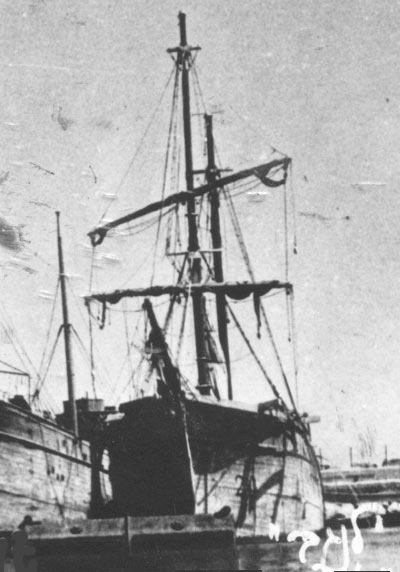
The 400 ton ship "Lanegev", carried 647 illegal immigrants, mostly Jewish orphans. The sea was high and perilous, water penetrated into the ship, immigrants scooped the invading water from the ship by buckets, because the water pumps were out of order. On the 5th of February we were caught by three British destroyers. 100 marines invaded the ship and conquered it in a short battle. The boat was towed into the Haifa harbor.
The immigrants were transfered to a British prisoner ship and were deported to detention camp no. 65 in Cyprus, on the day of February 9. 1947.
Each person was allowed to carry one knapsack
At about four a.m., the whistle blew; and we all lined up on the lawn. A line of trucks had come down the road; and we were shortly loaded aboard, about twenty-five people with baggage per truck. We drove silently through the quiet French countryside, much like a military convoy approaching the battlefield. As dawn broke, we saw the Mediterranean down below us. At last we drove through the seaport town of Sete and approached the waterfront. There were a number of ships in sight, and we wondered which one was our ship. We passed passenger ships, tankers, and freighters without stopping. We seemed to have traversed the whole length of the waterfront before finally coming to a halt. Nearby lay a one-masted wooden ship, not more than a hundred feet long. This, we were told, was the Lanegev. We stared in disbelief, finding it hard to accept that this tiny ship could carry hundreds of people, let alone sail the length of the Mediterranean.
Each person was allotted about a two-foot width shelf as a bed
The Lanegev had been an Italian fishing boat. She originally had had cabins for the crew of eight above the deck and one large hold below. But, like every ship of the Aliya Bet) she had been refitted for this voyage. A small auxiliary engine having been installed, five tiers of wooden shelves had been constructed in the hold, with an intermediate catwalk and ladders for access. The main deck had also been roofed over and the sides enclosed to accommodate more rows of shelves, three tiers high. These shelves, which were about six feet deep and covered almost every bit of available space in the ship, were our bunks. Each person was allotted about a two-foot width of shelf. People lay side by side, with heads toward the aisle. There was nothing to cover the bare boards except the blankets we had carried in our knapsacks. And about two feet above was the next shelf, which was arranged similarly, and above that the next, etc.
We sailed into the Mediterranean, January, 1947
We boarded the ship in an orderly manner and reclined in our assigned "bunks." In about two hours the full complement of six hundred fifty immigrants was aboard, and we were ready to sail. Again, we were under the command of an officer of the Hagana, who was assisted by two other Palestinians, a navigator and a radio operator. The Italian captain, of course, was in charge of the ship's crew; but, he, too, was under the orders of the Hagana commander. So it was that we sailed into the Mediterranean, that day in January, 1947.
Overloaded, terribly crowded, and lacking in adequate sanitary facilities
The voyage of the Lanegev was long and arduous, plagued by storms, and at times perilous. It was typical of the voyages of dozens of ships of the Hagana that sailed the Mediterranean during that period. They were usually old ships, overloaded, terribly crowded, and lacking in adequate sanitary facilities. But two things characterized all of them: the high morale of the passengers, who, despite the utter lack of physical comfort, knew that they were at last going home; and the fact that these ships brought their precious human
cargo safely to the territorial waters of Palestine, a truly remarkable record.
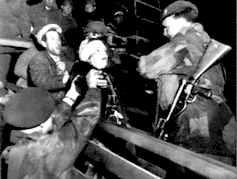 February 9, 1947 Armed British marines transfer immigrants from the Aliya Bet ship "Lanegev" to the British prison ship.
February 9, 1947 Armed British marines transfer immigrants from the Aliya Bet ship "Lanegev" to the British prison ship.
A battle against three ships of the royal navy
The Lanegev, using its sails and auxiliary engine, arrived within sight of the Palestinian shore on the night of the 21 day after it had put out of the port of Sete. Tired, but elated, we hoped to elude the British navy and land on the beach near Caesarea. But, as fate willed, we were sighted by a British destroyer as we attempted the final run to shore. There followed a minor battle against three ships of the royal navy. British marines boarded our ship, to be met by a hail of stones and broken bottles. Raking machine-gun fire from a destroyer finally cleared our decks (casualties: two immigrants were wounded and one of the English Habonim killed). With the marines in control above deck, we were taken in tow to Haifa. We were forcibly disembarked and put aboard a British troopship, which immediately set sail for Cyprus.
Army trucks whisked us away to the camp for "Illegal Jewish Immigrants."
Although the British were our "hosts" in Cyprus, they scarcely provided red-carpet treatment for our arrival. The troop transport anchored off the port of Famagusta, and lighters taxied us ashore. The military had cordoned off the port area, and waiting army trucks whisked us away to the camp for "Illegal Jewish Immigrants." There we were searched and questioned, then released inside the barbed wire enclosure among the immigrants who had arrived on Cyprus before us. About seven hundred immigrants already occupied the camp. In a way, it was a minor homecoming, for the other immigrants were anxious to know all about our trip, our battle with the British navy, and whether or not there were more immigrants waiting to sail from France. We, in turn, were anxious to know what sort of life they led in this British prison camp, what ships they had sailed, and how long we might have to remain here in Cyprus.
Tent city outside Famagusta
We soon learned that we were in the "summer camps," a makeshift tent city that the army had set up a few miles outside Famagusta. The rising tide of immigration had quickly made this area inadequate; and work had started several months before on a second, more permanent, area about twenty-five miles distant. There, German prisoner of-war labor had erected five adjoining Nissen-hut encampments, sufficient to accommodate another ten to twelve thousand people. It was to these "winter camps" that the passengers of the Lanegev were transferred within a few days. Little did the British then dream that the stream of Aliya Bet would grow so large as to require the construction of several more encampments.
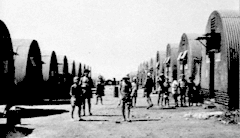 Detention camp no. 65 in Cyprus
Detention camp no. 65 in Cyprus
Feelings of hatred and mistrust toward the British soldiers
In one sense the Cyprus internment camps were prisons; and they evoked painful memories of Nazi concentration camps, from which many of the immigrants had "graduated." The camps were surrounded by high, barbed-wire fences. British soldiers manned the machine guns that were mounted on watchtowers at set intervals along the fences. Armed soldiers were stationed at the gates through which we received our food supplies, mail, etc. On several occasions, when panicky guards thought that people within were attempting to mob the gates, shots were fired, wounding a few of the immigrants. These episodes gave rise to feelings of hatred and mistrust toward the British soldiers.
Organized sanitation and food distribution
But, in another sense, the camps were autonomous Jewish republics. Both at the summer and winter camps there arose camp "governments," composed of representatives of all the groups and movements living within the camps. These governments acquired considerable responsibility and authority. They organized sanitation and food distribution. They acted as representatives of the immigrants whenever there were dealings with the British army authorities. And they were responsible for various cultural activities, holiday celebrations, and demonstrations.
Palestinian staff members raised the morale of the immigrants
The only outside organization that was officially permitted to help the internees was the American Jewish Joint Distribution Committee. The "Joint" sent one of its ablest field directors to Cyprus shortly after the establishment of the camps. The director, Mr. Morris Laub, brought quite a large staff of doctors, nurses, social workers, and teachers from Palestine and began to administer to the needs of the camp population. The fact that the 'Joint' staff members were Palestinians raised the morale of the immigrants and helped create a Hebrew atmosphere.
Hagana people were also smuggled into the camps
Unofficially, Hagana people were also smuggled into the camps. A comprehensive system of military training was set up by them, and thousands of people learned the elements of soldiering under the watchful eyes of British soldiers. The reply to British inquiries was that these were organized sports activities, intended to keep the internees occupied and away from mischief-breeding idleness. The sports activities consisted of marching, fighting with clubs, throwing (rocks being substituted for grenades), calisthenics, negotiation of obstacle courses, etc.
Camp No. 65 became the Children's Village
Among the immigrants were numerous groups of orphaned children, who had been organized by the various youth movements in Europe into aliya groups. Each group traveled with a madrich) who tried to be both parent and teacher. With the help of the "Joint," the British officials finally consented to house all of the children in one encampment; and so it was that Camp No. 65 became the 'Children's Village.'
Teachers came from Palestine
Teachers and emissaries of the youth movements came from Palestine as members of the 'Joint' staff, and a serious effort was made to provide for the education and well-being of these children. In walking through the children's camps, one had the feeling that this might almost be Ben Shemen or some other children's institution in Palestine.
Tools and materials were supplied to craftsmen
Idleness and boredom were much greater problems for the adults than for the children. The typical pattern of organization of the immigrants was the movement pattern, an extension of the political fragmentation that plagued the life of the Jewish community in Palestine and of the Zionist movement in Europe. Each movement had its own living quarters and its own communal kitchen and jealously guarded the interests of its members. But, aside from kitchen and other work details, there was not enough activity to keep people busy. The more active movements organized Hebrew classes and handicrafts, but most people had too much time on their hands. Here, too, the "Joint" stepped in. Teachers were brought from Palestine to conduct seminars for adults. Tools and materials were supplied to craftsmen. One could shop in the camps and buy buckets, teapots, tables and chairs, trousers -- all made by various craftsmen inside the camps.
Tools and materials were supplied to craftsmen
The key factor in our morale was the monthly aliya of seven hundred fifty persons. When the British learned that a ship had run the blockade and landed immigrants on the coast of Palestine, the quota for that month was arbitrarily suspended. In the camps, bitterness was rife; and morale fell to a low ebb. On one occasion, doctors recommended that all infants and pregnant women be transferred to Palestine at once. This could be accomplished, said the British, only by giving them the next monthly quota and postponing the regular transfer. To this the immigrants agreed. Later, the same arrangement was made for the children's camp; again, the adults agreed to a postponement in favor of the children.
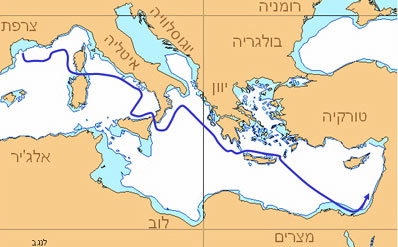 A year and half later, our long journey was completed
A year and half later, our long journey was completedIn this manner a whole year passed before the turn of the Lanegev passengers came for aliya. In January, 1948, British army trucks again carried us to Famagusta, where we boarded the Kedma, at that time the only Jewish passenger ship in service. On the Kedma we were treated as honored guests and had a comfortable overnight trip to Haifa. There we were met by some of our chaverim from America, who had, by means of experiments, found chinks in the British wall and had reached Palestine before us. At last our long journey was completed. It had taken us almost a year and a half to travel from the United States to Eretz
The saga of the "Lanegev" -- starting in Sette of France, 18. January 1947, and concluding on the 9. February 1947, captured and conquered by three destroyers of the British Navy.
In November, 1947, the United Nations created the Jewish state
When the passengers of the Lanegev arrived in Cyprus, in January, 1947, there were seven hundred internees already there. When we left, one year later, there were over thirty thousand, despite the monthly transfer of seven hundred and fifty to Palestine. Mr. Bevin's attempt to discourage aliya by opening Cyprus internment camps had been turned into a massive demonstration showing that the survivors of European Jewry would not be stopped in their determination to reach Palestine. World opinion showed that it had learned this lesson in the November, 1947, decision of the United Nations to create the Jewish state.
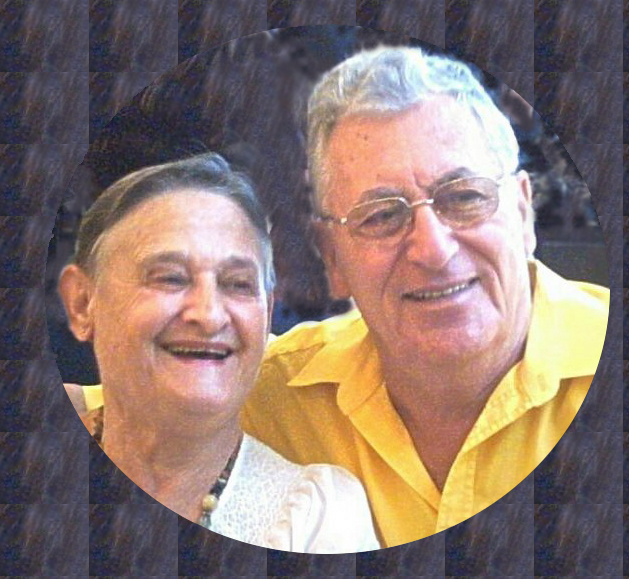
My wife, Judith and I today
Dear Olga, thank you for the great service you are doing for those people involved in the "Saga"of the Aliya Bet ship "Lanegev", en-route Germany- Palestine, by publishing this story and pictures. Anyone who has additioinal information may contact me. Rafi Ben Zur (nagy Jaki)
State Archives of the Republic of Cyprus:
CY-1461 Nikosia
Tel: +357 (2) 302 664
Fax: +357 (2) 667 680